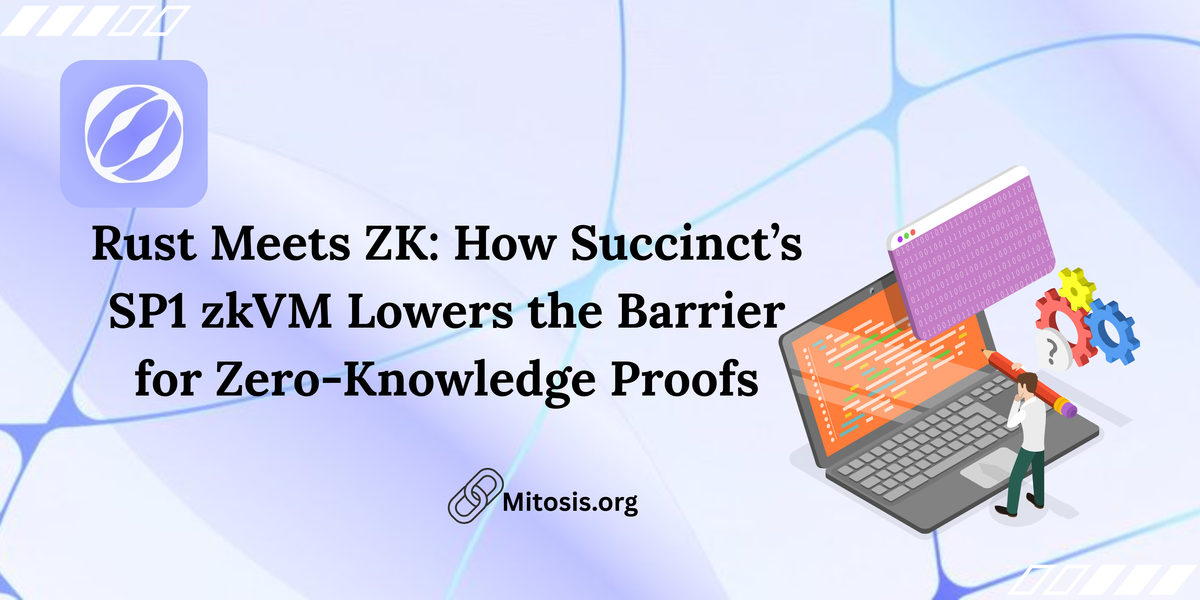Rust Meets ZK: How Succinct’s SP1 zkVM Lowers the Barrier for Zero-Knowledge Proofs

Succinct Processor 1 (SP1) is the fastest, most feature-complete zkVM available today, capable of proving the correct execution of arbitrary Rust or any LLVM-compiled programs. SP1’s alpha release already demonstrates up to 28× performance gains over existing zkVMs on real blockchain workloads, such as Tendermint light clients and type-1 zkEVM implementations. By drastically improving proof generation speed and ease of use, SP1 transforms ZKP development from a niche specialty into accessible software engineering. See https://github.com/succinctlabs/sp1?,
Unlike closed-source alternatives, SP1 is 100% open-source (MIT/Apache-2.0), inviting collaboration through GitHub and community channels. Its modular architecture allows contributors to swap in new proof systems and customize “precompile” modules, accelerating cryptographic primitives without rewriting the core VM.
In my opinion, this openness ensures SP1 stays at the cutting edge of proof system advances, avoiding stagnation common to proprietary stacks. See https://blog.succinct.xyz/introducing-sp1/?
SP1 Architecture and Design
RISC-V-Based Execution
SP1 targets the RISC-V instruction set, compiling Rust programs into ELF binaries using standard Rust toolchains. Under the hood, SP1’s virtual machine simulates CPU, memory, and ALU components, then generates STARK proofs of their correct operation.
In my opinion, leveraging RISC-V enables compatibility with any LLVM-compiled language, decoupling ZKP logic from domain-specific frameworks. See https://docs.succinct.xyz/docs/sp1/what-is-a-zkvm?
STARKs with Recursive Wrapping
The core proof system combines STARKs (and FRI over the Baby Bear field) with performant recursion, allowing proofs of arbitrarily long program executions to be “wrapped” into succinct SNARKs for on-chain verification. SP1’s customizable precompiles further accelerate hotspot functions like hashing and signature checks, yielding major performance boosts.
In my opinion, this hybrid STARK→SNARK approach balances proof size and verification cost, making SP1 ideal for EVM and non-EVM chains alike. See https://docs.succinct.xyz/docs/sp1/what-is-a-zkvm?
Contributor-Friendly Modularity
All SP1 constraint logic is open and extensible: developers can add or tune chips (e.g., for elliptic-curve ops) without altering core code. SP1’s “awesome-sp1” repository curates tutorials, tools, and community projects to lower the learning curve. By treating the zkVM as a library of plug-and-play components, SP1 enables rapid iteration and ecosystem growth. See https://github.com/gakonst/awesome-sp1?
Advantages for Rust Developers
Write ZKP in Plain Rust
SP1 lets developers write proof logic using everyday Rust crates—revm, reth, alloy, and more—without circuit DSLs or IRs. You simply compile existing Rust code to RISC-V and run cargo proveThis erases the steep learning curve of ZKP frameworks, democratizing proof development. See https://www.aicoin.com/en/article/455108?
Drastically Improved Productivity
By reusing standard libraries and avoiding separate circuit definitions, SP1 can boost development speed by orders of magnitude—up to 100× in some benchmarks. Teams can focus on application logic rather than proof plumbing. Faster development cycles translate directly into more robust, audited ZKP features in production. See https://www.panewslab.com/en/articledetails/si6d15sj.html?
End-to-End Tooling
The sp1-sdk crate and CLI tools (cargo prove) automate setup, key generation, proof production, and verification—locally or via Succinct’s beta prover network. Having a unified toolchain reduces context switching and integration friction, essential for large-scale DeFi stacks.
Integration with Mitosis and DeFi
Mitosis’s Matrix Vaults automate cross-chain strategy deployment; integrating SP1 allows on-chain proofs of correct vault execution, enhancing trust without centralized oracles. zkVM-based validation ensures vault yields and rebalances occur as governed, bolstering user confidence.
Additionally, SP1 proofs can run within smart contracts to verify miAsset minting events from Mitosis’s Ecosystem-Owned Liquidity pools, reducing reliance on off-chain relayers. Embedding zkVM verification on-chain closes trust gaps and minimizes external dependencies.
Combining SP1 with Mitosis’s Hyperlane messaging layer offers atomic cross-chain proof relays, users could deposit assets on one rollup and receive proof-backed miAssets on another in a single transaction flow. This synergy exemplifies fully decentralized, proof-driven capital mobility in DeFi. See https://blog.mitosis.org/
Security and Community Governance
Transparency and Audits
A critical SP1 vulnerability discovered by LambdaClass in early 2025 was publicly patched and documented, sparking debate on ZK security disclosure. SP1’s open-source nature ensures issues are community-vetted and resolved rapidly. Public audits and transparent patch processes build trust, essential for financial-grade infrastructure. See https://blockworks.co/news/succinct-sp1-bug?
Contributor-Driven Evolution
Succinct Labs encourages community contributions via GitHub and Discord, with paid bounties for new precompiles and proof-system modules. A thriving contributor base accelerates feature rollout and fosters resilience against stagnation.
Future Directions
SP1 Turbo and GPU Acceleration
The upcoming “SP1 Turbo” release promises GPU-cluster proofing, verifying Ethereum blocks in 40 seconds at minimal cost. GPU support will unlock large-scale batch proofing for enterprise and DeFi pipelines. See https://www.aicoin.com/en/article/455108?
Expanded Language Support
While Rust is the primary target, SP1’s LLVM foundation paves the way for C, C++, and even Python via LLVM support in future releases. Broader language compatibility will attract more Web2 developers to ZKP. See https://docs.succinct.xyz/docs/sp1/what-is-a-zkvm?
Integration with Rollup Engines
SP1’s role in next-gen rollups—like those powered by Caldera—will grow as ZK becomes a native part of layer-2 security and state verification. Embedding zkVM proofs in rollup cores enhances throughput and trust, heralding the “ZK everywhere” trend.
Conclusion
Succinct SP1 zkVM represents a pivotal advancement in zero-knowledge technology, breaking down barriers for Rust developers and enabling performant, auditable proofs in real-world applications. By combining RISC-V execution, STARK-based recursion, and an open, modular architecture, SP1 accelerates the adoption of ZKP in DeFi, secure rollups, and beyond. Integrations with platforms like Mitosis demonstrate how SP1 can infuse trust and automation into cross-chain liquidity strategies, creating a future where every smart contract and vault action is verifiable by anyone, anywhere—truly programmable trust without compromise.
🔗Links:
🚩 Twitter,

Comments ()